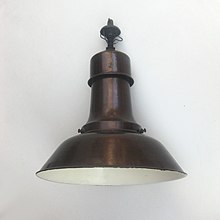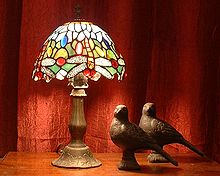Light fixture

A light fixture (US English), light fitting (UK English), or luminaire is an electrical device used to create artificial light by use of an electric lamp. All light fixtures have a fixture body and a light socket to hold the lamp and allow for its replacement. Fixtures may also have a switch to control the light. Fixtures require an electrical connection to a power source; permanent lighting may be directly wired, and moveable lamps have a plug. Light fixtures may also have other features, such as reflectors for directing the light, an aperture (with or without a lens), an outer shell or housing for lamp alignment and protection, and an electrical ballast or power supply.[1] A wide variety of special light fixtures are created for use in the automotive lighting industry, aerospace, marine and medicine.
The use of the word "lamp" to describe light fixtures is common slang for an all-in-one luminary unit, usually portable "fixtures" such as a table lamp or desk lamp (in contrast to a true fixture, which is fixed in place with screws or some other semi-permanent attachment). In technical terminology, a lamp is the light source, what is typically called the light bulb. (See Lamp (electrical component).)
Light fixtures are classified by how the fixture is installed, the light function or lamp type.
Light fixture is US usage; in British English it is called a light fitting. However, luminaire is the International Electrotechnical Commission (IEC) terminology for technical use.
Fixture types
History

- Fixture manufacturing began soon after production of the incandescent light bulb. When practical uses of fluorescent lighting were realized after 1939, the three (3) leading companies to produce various fixtures were Lightolier, Artcraft Fluorescent Lighting Corporation, and Globe Lighting in the United States.[2]
Free-standing or portable

- Table lamp fixtures, standard lamp fixtures, and office task light luminaires.
- Balanced-arm lamp is a spot light with an adjustable arm such as anglepoise or Luxo L1.
- Gooseneck lamp
- Nightlight
Fixed
- Recessed light — the protective housing is concealed behind a ceiling or wall, leaving only the fixture itself exposed. The ceiling-mounted version is often called a downlight.
- "Cans" with a variety of lamps — this term is jargon for inexpensive downlighting products that are recessed into the ceiling, or sometimes for uplights placed on the floor. The name comes from the shape of the housing. The term "pot lights" is often used in Canada and parts of the US.
- Troffer — recessed fluorescent light fixtures, usually rectangular in shape to fit into a drop ceiling grid.
- Cove light — recessed into the ceiling in a long box against a wall.
- Torch lamp, torchière, or floor lamp.

- Surface-mounted light — the finished housing is exposed, not flush with surface
- Chandelier
- Pendant light — suspended from the ceiling with a chain or pipe
- Sconce — provide up or down lights; can be used to illuminate artwork, architectural details; commonly used in hallways or as an alternative to overhead lighting.
- Track lighting fixture — individual fixtures ("track heads") can be positioned anywhere along the track, which provides electric power.
- Under-cabinet light — mounted below kitchen wall cabinets
- Ceiling fan - May sometimes have a light, often referred to as a light kit mounted to it.
- Emergency lighting or exit sign — connected to a battery backup or to an electric circuit that has emergency power if the mains power fails
- High- and low-bay lighting — typically used for general lighting for industrial buildings and often big-box stores
- Strip lights or industrial lighting — often long lines of fluorescent lamps used in a warehouse or factory


- Outdoor lighting and landscape lighting — used to illuminate walkways, parking lots, roadways, building exteriors and architectural details, gardens, and parks.
- Pole- or stanchion-mounted — for landscape, roadways, and parking lots
- Pathway lighting — typically mounted in the ground at low levels for illuminating walkways
- Bollard — A type of architectural outdoor lighting that is a short, upright ground-mounted unit typically used to provide cutoff type illumination for egress lighting, to light walkways, steps, or other pathways.
- Wallpack Light - A type of light fixture mounted to exterior walls of a building and configurable to light in many directions, most commonly down and outwards.
- Sign light — used to light building signs or walls
- Street light pole
- Street light
- Yard light
- Garden lights - line and low voltage, and solar.
- Solar lamp
Special-purpose lights
- Accent light — Any directional light which highlights an object or attracts attention to a particular area
- Background light — for use in video production
- Blacklight
- Christmas lights-also called fairy lights or twinkle lights and are often used at Christmas and other holidays for decoration.
- Flood light
- Safelight (for use in a darkroom)
- Safety lamp (for use in coal mines)
- Searchlight (for military and advertising use)
- Security lighting
- Step light
- Strobe light
- Traffic light
- Theatrical
- Wallwasher
Lamp types

- Fuel lamps
- Betty lamp, butter lamp, carbide lamp, gas lighting, kerosene lamp, oil lamp, rush light, torch, candle, Limelight, gas mantle
- Safety lamps: Davy lamp & Geordie lamp
- A-lamp, Parabolic aluminized reflector lamp (PAR), reflector lamp (R), bulged reflector lamp (BR) (refer to lamp shapes)
- Obsolete types: limelight, carbon button lamp, Mazda (light bulb), Nernst glower
- Novelty: Lava lamp
- Special purpose: heat lamp, Globar, gas mantle
- Halogen – special class of incandescent lamps
- Gas-discharge lamp and high-intensity discharge lamp (HID)
- Mercury-vapor lamp, Metal-halide (HMI, HQI, CDM), Sodium vapor or "high-pressure sodium"
- Cold cathode
- Fiber optics
- Light-emitting diode (LED) (solid-state lighting)
- Nuclear: self-powered lighting
Light-fixture controls
- Light switch (often part of the light socket or power cord on portable fixtures)
- Dimmer
- 3-way 2-circuit switch
- Motion detector
- Timer
- Touch
- X10 (industry standard) systems
- Lighting control system
See also
- Architectural lighting design
- Coefficient of utilization
- Flashlight
- History of street lighting in the United States
- Lighting designer for the theater
- List of light sources
- Luminous efficacy
- Timeline of lighting technology
References
- ^ Sylvania lighting glossary
- ^ "Early industry leaders", of fluorescent fixture manufacturing, Paul Levy (1998)
External links
- Look at the Chart and Pick Out the Reflector You Need, Popular Science monthly, February 1919, page 75, Scanned by Google Books: http://books.google.com/books?id=7igDAAAAMBAJ&pg=PA75
